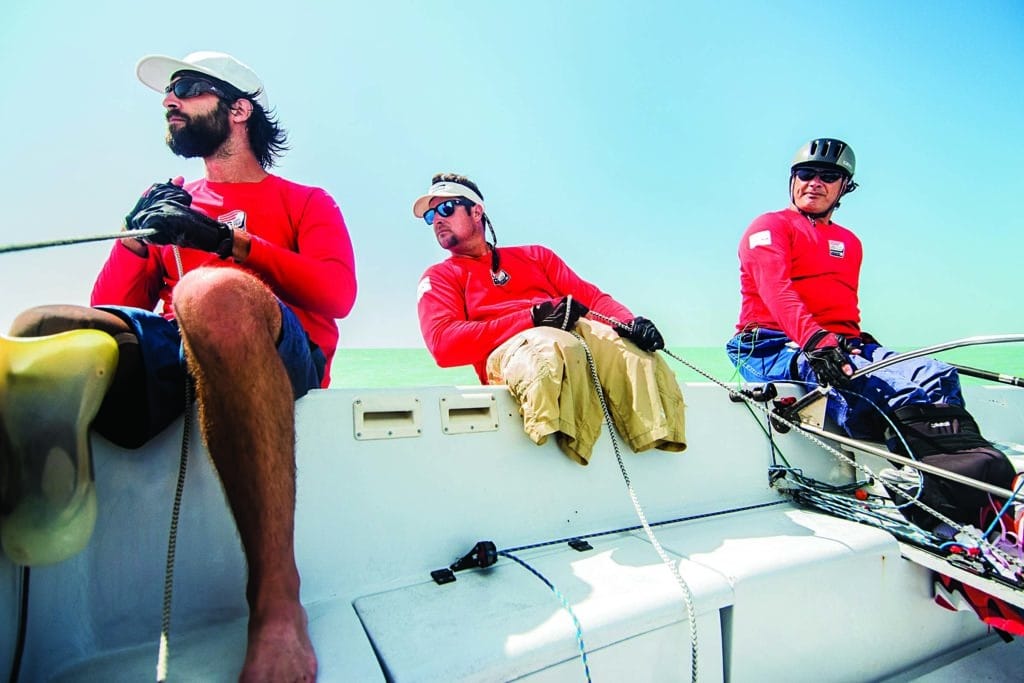
When I first started coaching for the US Sailing disabled program, someone explained to me that although training for the Olympics is the hardest thing an athlete will ever do, most Paralympians have already been through something much harder. The Paralympic athletes I know rarely compare their disabilities among one another, so to lump them all into one group is hugely misleading, because disabled or otherwise, they have unique stories and hyperspecific training to match. That said, fielding a team of three sailors for the Sonar is not easy. The campaign is long and hard, so the athletes must have chemistry, their total crew weight must be near spot on, and of course, they need the right mix of sailing skills.
As if that’s not enough, Paralympic sailors must first be classified. Classification is taken seriously. International doctors follow guidelines to rate each athlete on a scale of 1 (typically quadriplegic) to 7 (typically missing a leg below the knee). Sonar Team USA 1 has Rick Doerr on helm, Brad Kendell on main trim and tactics, and Hugh Freund on jib trim and bow. Freund is a 7, Kendell is a 4, and Doerr is a 3, adding up to 14, which is the maximum allowed combination for the Paralympic Sonar.
Doerr has a spinal injury he sustained in a car accident. He is paralyzed from the seventh thoracic vertebra down, so he has no core support and cannot move his legs. He has a fiberglass bench spanning the cockpit and a stainless bar from rail to rail so he can slide himself across the bench. He then “bumps” himself up on the rail with his triceps, and without core strength, he holds his body upright with his hand on the bar. His legs are strapped together to prevent his feet from getting ensnared.
Kendell lost both of his legs above the knee in a plane crash when he was 22. He often wears “stubby” legs while racing, but he is agile and strong, so he can get around the boat without further boat adaptations.
Freund lost his leg to cancer in his freshman year at Roger Williams University. He’s considered the equivalent to able-bodied (an 8, if there were such a classification) with his prosthetic leg on, so he can’t wear it while sailing. Instead he uses a cap resembling a giant eraser, just below the knee, onto which he can lean. He is highly mobile even with his eraser.
These three have a different perspective on just about everything. After the 2015 Sailing World Cup Miami, I noted to myself, “Never complain about anything ever again.” Only weeks before the World Cup, Doerr was released from the hospital after 75 days of fighting an infection in his skin that had spread to his pelvis. Infections under prosthetics are common among all three of them, which adds another layer of complexity to the campaign.
Going into the World Cup, for example, one of two qualifying events for the team, Doerr wasn’t himself at all: He was 35 pounds lighter, and intense, prolonged antibiotics had wrecked his body. He was exhausted, sleeping 16 hours a day. In true fashion, however, his teammates stepped up, dealing with everything from rig to de-rig. Doerr was dropped into the boat for his few waking hours each day, and then, after a short visit to the US Sailing Team physical therapist, he went straight to bed to recover.
The team finished with a silver medal, which is an impressive accomplishment, excessive adversity aside. Never a single complaint was uttered — not from Doerr about his exhaustion, nor from Kendell or Freund about the extra responsibilities. The situation was, as they say, the way it was. Situation normal. Stay the course.
Though they train hard, these athletes have an old-school grass-roots sailing attitude. Doerr is in his element rolling around the parking lot jarring with competitors, often flanked by his wife, Joann. Meanwhile Kendell is doing handstands off the deck and into the water. Freund is always easygoing and quick with a joke.
Kendell: “I was two steps ahead of you on that one.”
Freund: “Can’t be. You have no legs.”
For them, even though racing at the Olympic and Paralympic level is intense, laughter has its place too. If one happens upon a boat park and finds three guys playing croquet with their prosthetic legs, or wheelchair-racing scary-fast down a large hill, it’s them, making their way to Rio, one — ahem — step at a time.









